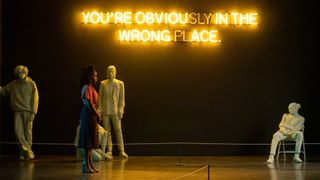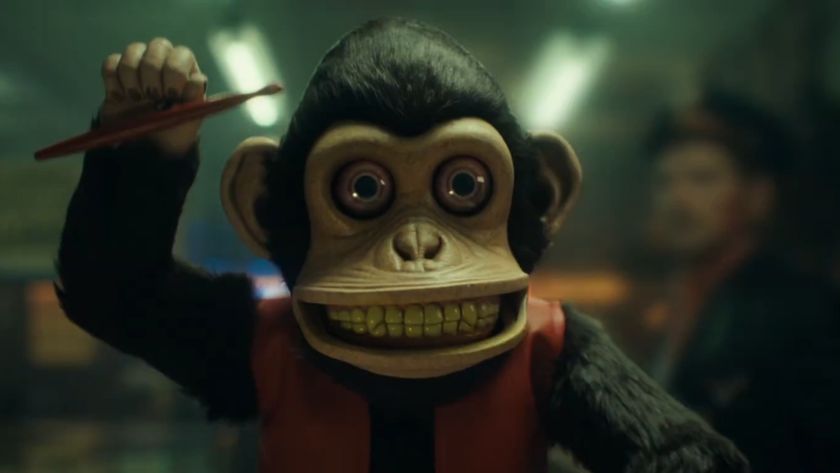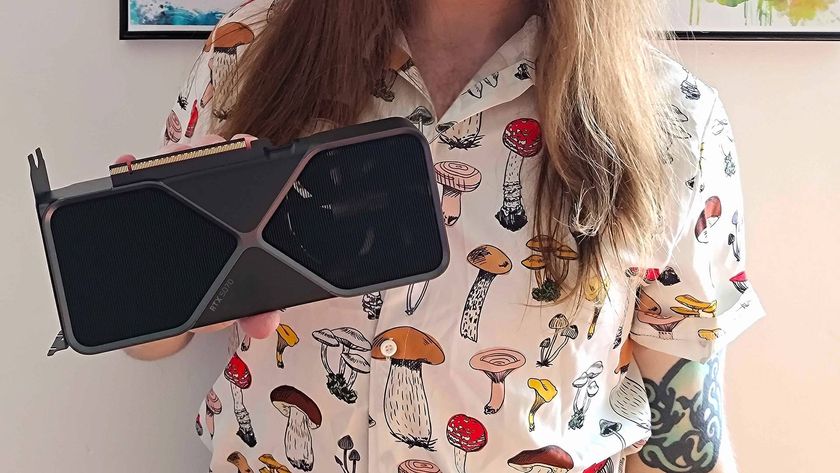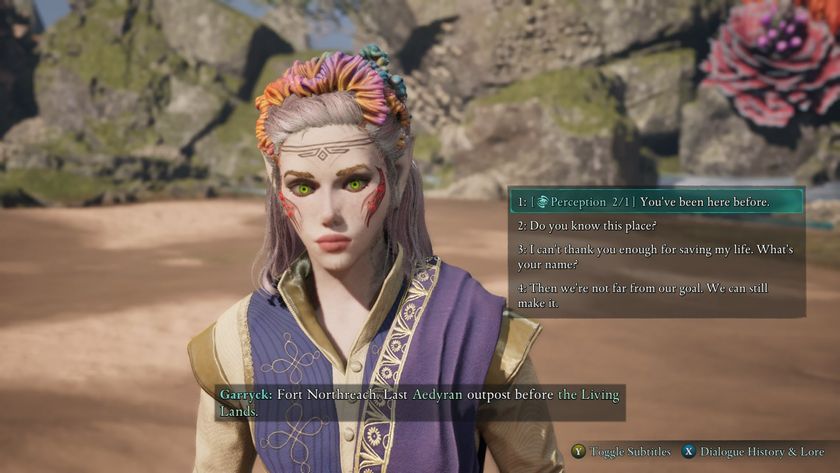Candyman: Nia DaCosta, Yahya Abdul-Mateen II, and Teyonah Parris talk terrors new and old
A reimagining of one of the scariest – and most politically charged – genre movies ever made, the new Candyman is a horror for the Black Lives Matter era

12DOVE and Total Film are celebrating the biggest new releases as we head back to the cinema! This week: Candyman. Director Nia DaCosta and stars Yahya Abdul-Mateen II, and Teyonah Parris discuss terrors new and old, imagined and all too real... This article first appeared in print in 2020 – buy the magazine here.
"I was in Harlem," starts Nia DaCosta, the director of the new imagining of Candyman. She’s trying to recall the first time she watched Bernard Rose’s 1992 original, a horror movie so terrifying it’s still whispered of to this day. And here’s the thing: she can’t. "I was in the fifth or sixth grade, and I just remember Candyman being a part of life," she muses. "Like legend, lore. We didn’t dare say his name in the mirror. For me, Candyman felt so real. It felt like he could totally exist in the projects by my house."
For leading man Yahya Abdul-Mateen II, it’s the same. "Man, I remember images of Candyman but I don’t remember sitting down to watch the movie," he says. "He lived in my imagination, in the retelling of Candyman. I grew up with Candyman not being a figure from television or movies, but with the possibility of him being a real threat within the house. The dread of Candyman was palpable."
Is there a theme here? It seems so. "I wasn’t allowed to watch the movie, but I remember seeing the image of Candyman," shudders female lead Teyonah Parris. "We knew we were not supposed to say ‘Candyman’ in the mirror five times. My brothers and I would taunt each other with that. The legend of Candyman was definitely a part of my childhood."
All in their early thirties, DaCosta, Abdul-Mateen and Parris were nippers when the original Candyman came out, and it’s fitting that it reached them by word of mouth. Rose’s film, based on Clive Barker’s short story The Forbidden in Volume V of the Books Of Blood (1985), is, after all, about the power of myth. In it, student Helen Lyle (Virginia Madsen) decides to write a thesis about local legends, and visits the Cabrini-Green housing project on Chicago’s North Side (or, in Barker’s story, the fictional Spector Street Estate in Liverpool), where a hook-handed killer is rumoured to appear if you dare say his name five times in front of a mirror. "Our crimes will be written on a thousand walls... told and retold by our faithful believers," purrs Candyman (Tony Todd) when he duly manifests. He is a terrifyingly seductive killer, powered by urban legend as surely as Freddy Krueger is fuelled by fear and bad dreams in A Nightmare On Elm Street. He is, to pinch a line from The Forbidden, "immortal in gossip and graffiti."
To remake (or to offer a "spiritual sequel" to) such an iconic horror movie would normally be considered foolish: genre fans didn’t exactly dance with glee when it was announced that the likes of The Fog, Poltergeist and The Wicker Man were getting reboots, and their worst fears were, if anything, not bleak enough. But with Candyman, there is only anticipation. Call it the 'Jordan Peele Effect', for it’s the man who gave us Get Out and Us who is behind the new Candyman, not only co-writing (with Win Rosenfeld and DaCosta) but producing – Monkeypaw Productions, the company he founded in 2012, is Candyman’s new home. But with Peele’s seal of quality comes its own pressures...
Taking the myth

"The original was a landmark film for Black representation in the horror genre," said Peele in a statement released after the new Candyman was announced, in November 2018. "Alongside Night of the Living Dead, Candyman was a major inspiration for me as filmmaker. We are honoured to bring the next chapter in the Candyman canon to life."
Sign up for the Total Film Newsletter
Bringing all the latest movie news, features, and reviews to your inbox
DaCosta draws in a breath. "There are expectations around Jordan: what kind of movie is he going to make, and what cultural impact is it going to have? I never usually think about that when I’m making TV or a film. So I was like, 'Oh wow'."
These worries came later. At the start, DaCosta just knew she wanted the gig.
"I found out about it through my agent, who knew how much I like horror and how much I wanted to do a genre film,” she says, telling of how, as a kid, she used to watch Tales From The Crypt and Freddy movies all by herself, at night, to maximise scares. "My agent was like, 'Well, I have the perfect thing for you'. And then it was a process of sending my work to Monkeypaw, and telling them who I was, and pitching."
DaCosta had directed 2018’s Little Woods and has been announced as Marvel’s first Black female director as the new helmer for Captain Marvel 2. And as for her pitches, well, Peele and Rosenfeld already had a script but it changed a lot once DaCosta boarded. "We collaborated on it for a couple of years," she says. "Win and Jordan were the co-writers, and then when we got to Chicago and started prep, I started writing on it because there was just so much I was learning on the ground and so much I wanted to get in the script. We were passing it back and forth and having conversations."

Congenial conversations? After all, a director working for another director, now in the role of producer, is not always the best recipe for success. Look at Tobe Hooper and Steven Spielberg on the original Poltergeist.
"It was a really easy collaboration," says DaCosta. "Jordan was always available and really helpful – especially with dealing with the studio. It was always a negotiation, because we have very different aesthetics, very different tastes. How do I as a filmmaker maintain my vision when I’m working under another filmmaker? But he was very supportive. The reason we were able to collaborate is that he’s just a really good person. I was always amazed by how deferential he was. It was great to work with him."
One thing they agreed on immediately was that Abdul-Mateen and Parris were the actors to lead the cast. The former read for Get Out and had a small part in Us; Peele was determined to find him a bigger role worthy of his talents, and told DaCosta, "I really love his work, he elevates everything he’s in" – some praise given the things he’s in include Aquaman, as Black Manta, and HBO’s stunning miniseries Watchmen, playing Cal Abar, host of Dr. Manhattan. Parris, meanwhile, caught the eye of DaCosta (and everyone else) with her high- voltage performance in Spike Lee’s incendiary Chi-raq, and as Ernestine Rivers in Barry Jenkins’ sublime adaptation of James Baldwin’s If Beale Street Could Talk.

Both actors fell in love with their characters. "Anthony McCoy is a painter from Chicago," says Abdul-Mateen. "He came out of art school and was hailed as the next big thing. We find him a while after that moment has slipped his grasp and he’s looking for inspiration. He goes back to Cabrini- Green looking for a story. Things start to happen around him that he’s drawn to for some odd reason. It puts a strain on his professional relationships and his personal relationships."
Cartwright is the girlfriend of Anthony, and she is an arts curator in Chicago. She and Anthony have been together for a while, and when Anthony is unable to produce work, you see how this ambitious, smart woman is trying to support her equally ambitious, but cut-from-a-different-cloth boyfriend during this hard time.” She chuckles. “And just how it all spirals out of control, unexpectedly.”
If you paid close attention to what Abdul-Mateen was saying, you’d have noticed he said that Anthony “goes back to Cabrini-Green”, and this is where the “spiritual sequel” part comes in – Anthony was the baby who Candyman kidnapped and used as bait in the original movie. Now all grown up (and with this film wisely ignoring that 1995’s Candyman: Farewell To The Flesh and 1999’s Candyman: Day Of The Dead ever existed), he returns to the place that he was born, looking for inspiration. What he finds instead... well, let’s just say it’ll be a big hook to viewers.
Terror vision

But before we get to Candyman, let’s pause for a moment to survey our surroundings, for Cabrini-Green is now a very different prospect to when the first movie was made. With major redevelopment carried out since the late ’90s, upscale high-rise buildings hold sway.
“Gentrification is an act of modern violence,” says DaCosta, touching on one of her film’s main themes. “We explore how it affects Cabrini-Green and the people who live there.”
Abdul-Mateen agrees. “It’s a story about others, a story about outsiders versus insiders, about what happens when intruders come in and the consequences of that,” he says. “The threat of gentrification is a horror story in and of itself, with people being displaced, and all of a sudden the faces are different, and things that used to be easy and familiar become distant and challenging. It’s a great opportunity for Candyman to haunt new faces. What happens when the ghost stays, but the people who he haunts change? Is this monster motivated by the same things? And what’s the response to that?”
Giving the movie a sharp socio-political edge is in keeping with Bernard Rose's original. Before Candyman, Black representation in horror was appalling – with very few exceptions, it was limited to reductive tropes: a two-dimensional supporting Black character with mystical powers who often useses them to issue warning to the white protagonist or a Black supporting character who is killed off, usually while saving a white lead. And then, in the '70s, came a wave of often shoddy Blaxploitation titles. As Peele has pointed out, Candman was one of the very first mainstream horror movies to speak to a meaningful Black experience, with its bogeyman created by a horrifying act of racial violence. The son of a slave, he had his hand hacked off and honey smeared all over him before being thrust into an apiary, and all for being in love with a white woman. The theme of gentrification was also touched upon in Rose’s movie, with Helen’s pastel-hued apartment being an ex-housing project. Such touches led Robert Ebert to declare, "What I liked was a horror movie that was scaring me with ideas and gore, instead of simply with gore."

In the new Candyman, gentrification is key, and DaCosta also points out that Anthony and Brianna have another, all-too-real horror to contend with: "There are micro-aggressions when you’re working as a Black artist in a white industry," she points out, saying it’s a theme that she personally identified with. "Even on this movie, all the execs who worked on the film were white, except for Jordan. There were Black creatives, but in terms of producers and executives, they were almost exclusively white. So absolutely I can relate to this."
As for Parris, she wouldn’t have signed on if Candyman didn’t have important things to say. "I view myself as a very socially aware person, but my thing is not necessarily getting out there and making speeches and being the face of political things. I’m not very good at that. But I use my work to speak on the issues that mean something to me. Obviously I’m a Black woman, so you can’t help but see it in that lens – 'OK, this is a Black woman’s story, and what does it say about Black people?' That always goes into me choosing what it is that I lend my voice to. It gives people the space to talk about things that may be uncomfortable."
DaCosta realises it’s an extremely sensitive time for Candyman to land. "It really feels like we’re going through a second Civil Rights movement in the States, and across the world," she says. "So if this film can exist in that space and be an aid or a salve, I’m happy for it to be. When we made it, I knew this would happen again. Being a Black person in America, you live with this expectation, or realisation, of violence, every day. It is a very poignant time for the film to be coming out. I hope it’s not triggering, but more a space for..." She scrabbles for the correct word. "Catharsis."
Scare Fare

Time’s nearly up, and there’s been so much to get into that we haven’t even discussed if DaCosta is confident that the new Candyman, for all of its urgent subtext, can also deliver as a Friday night horror movie – y’know, scare viewers shitless. It’s a tricky subject given that
Total Film has been warned that no one will discuss who’s playing Candyman – the filmmakers want it to be a surprise. OK, we’ll keep it general. Is Candyman 2020 scary?
"The first preview screening, I was actually laughing, because the reaction..." DaCosta guffaws at the memory. "There’s a lot of body horror in the film, which is very important to me, and the reaction to that was so strong! We did good!"
So it’s going to be gory? Rose’s film has a character "split from his crotch to his gullet", as another character puts it, while Barker’s The Forbidden poses a deliciously sick question: "What’s blood for, if not for shedding?"
"It will be R-rated, absolutely," says DaCosta. Another big laugh. "We’re not holding back!"
Candyman reaches cinemas August 27, 2021. For more long-form features on the biggest releases of the year, be sure to check out our celebration of going back to the cinema!
Jamie Graham is the Editor-at-Large of Total Film magazine. You'll likely find them around these parts reviewing the biggest films on the planet and speaking to some of the biggest stars in the business – that's just what Jamie does. Jamie has also written for outlets like SFX and the Sunday Times Culture, and appeared on podcasts exploring the wondrous worlds of occult and horror.













